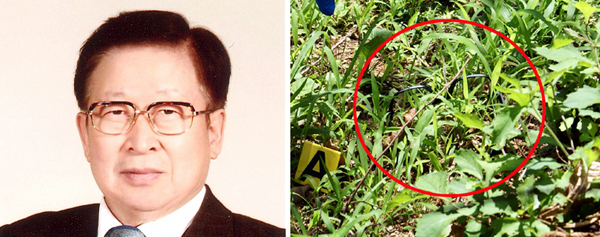Yoo’s autopsy may not fully settle cause or time of his death
Published: 24 Jul. 2014, 20:45

Left: A portrait of Yoo Byung-eun provided to Newsis when he won an award in 2007. Right: The glasses found yesterday 1.5 kilometers (0.93 mile) away from where Yoo’s body was found on June 12. [NEWSIS]
But experts said a conclusive cause of death may be elusive considering the wretched state of Yoo’s corpse when it was discovered more than six weeks ago - which is bound to fuel already rampant conspiracy theories of a government cover-up.
Five forensic pathologists in Korea contacted by the JoongAng Ilbo agreed that it would be hard to trace the cause of Yoo’s death since about 80 percent of the body is known to have decayed.
The NFS is known to be looking for any trace of external injury on Yoo’s body using a high-end computer tomography (CT) scanner and trying to detect toxic substances that may have killed him.
The first thing to look for to determine a cause of death is damage to the victim’s skin such as bruises or piercing wounds. If there is a bruise, forensic pathologists analyze whether it relates to the victim’s death. Strangling, for example, leaves marks on the neck.
But in Yoo’s case, such surface inspection won’t go far because maggots ate most of his skin tissue.
“His neck was so decayed that the neck bone was exposed,” said Lee Yeong-jik, forensic pathologist at the St. Carollo Hospital in Suncheon, South Jeolla, who did the initial autopsy of Yoo’s body before authorities knew the identity of the corpse. “So in the first autopsy I could not tell whether Yoo was murdered or killed himself.”
Forensic pathologists also check whether the person died of natural causes by checking the condition of internal organs. For instance, when calcification is found in blood vessels around the heart, doctors may conclude the victim died of heart disease. Such speculation can be even more precise when checked against the person’s past medical records.
“I assume Yoo’s internal organs are already severely damaged,” said Lee Ho, a professor of forensic science at the Chonbuk National University. “It is unlikely that the NFS can find traces of any diseases Yoo may have had.”
One good chance is to detect toxic substances, which can be discerned in a small amount of tissue. In the case of muscle, only 20 grams are needed to detect toxic material. The current technology can detect a gram of toxin dissolved in 1,000 tons of water.
“But the condition of Yoo’s remaining muscle is not good,” said Park Ui-wu, forensic science professor at Konkuk University. “Even if toxic material killed him, we can’t rule out the possibility that the material will go undetected.”
Even if a toxic substance is found in his body, it will be hard to tell whether he was poisoned or killed himself.
Another complicating factor is that the second autopsy began 40 days after the body was found.
“Although the body has been kept in a morgue, the body’s condition may have changed,” says Lee Yun-seong, a forensics professor at Seoul National University.
Analysts say it will not be possible to estimate when Yoo died either. The typical way of gauging the time of death is measuring the body temperature, which would have been useless when Yoo’s remains were discovered June 12, since they had lain in an orchard for days or weeks. One method would have been to carefully study the maggots on Yoo’s body, measuring their length and shape. But the analysts assume that wasn’t done.
“To estimate the time of death by looking at bugs, field investigation is needed to check the environment,” said Park Seong-hwan, a professor of forensic science at the Korea University. “They could have used a variety of forensic techniques if they suspected the body was Yoo’s in an early stage.”
BY AHN HYO-SUNG [bongmoon@joongang.co.kr]










with the Korea JoongAng Daily
To write comments, please log in to one of the accounts.
Standards Board Policy (0/250자)